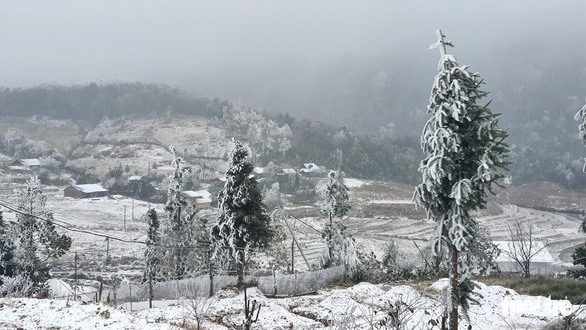 Society
Society

The extreme cold weather, between January 7 and January 12, has killed over 540 cows and buffaloes as well as damaged about 93 ha of crops in northern mountainous provinces of Cao Bằng, Lào Cai, Điện Biên, Sơn La, Lai Châu, Lạng Sơn and Yên Bái.

|
Snow covered Y Tý Commune, Bát Xát District, Lào Cai Province in on January 11. — Photo tuoitre.vn
HÀ NỘI — The extreme cold weather, between January 7 and January 12, has killed over 540 cows and buffaloes as well as damaged about 93ha of crops in northern mountainous provinces of Cao Bằng, Lào Cai, Điện Biên, Sơn La, Lai Châu, Lạng Sơn and Yên Bái.
The damage, caused by the freezing temperatures, was mitigated as residents took measures to shelter most animals and protect crops.
Nguyễn Như Cường, head of the Department of Crop Production under the Ministry of Agriculture and Rural Development, said most people in the mountainous provinces were already aware of keeping their animals and plants warm during the winter.
Farming households set up lamps for plants and increased food for animals during the cold snap, he said.
Nguyễn Thị X, owner of a large herd of cattle in Than Uyên District, Lai Châu Province, said her family prepared the farm and stored enough straw from the beginning of the harvest season. The current cold weather did not affect the cattle.
In Yên Bái Province, Nguyễn Văn Hòe, head of Agriculture and Rural Development Office of Trạm Tấu District, said the office sent its staff to every village to instruct local residents to take measures to protect animals and plants from the cold.
Nguyễn Văn Long, deputy director of the ministry’s Department of Animal Health, said hoarfrost was also identified as a natural disaster, so owners of dead cattle could receive financial support from the State in accordance with Decree No 02/2017-NĐ-CP.
Currently, localities are compiling statistics on damage to report to the Central Steering Committee on Natural Disaster Prevention and Control’s Office to receive financial support.
It is estimated that there are over 3.4 million cattle in the northern mountainous provinces.
In a related movement, the National Centre for Hydro-meteorological Forecasting warned that another extreme cold spell would hit the northern region on Sunday. The extreme cold spell was forecast to last two or three days. — VNS




